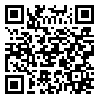Volume 6, Issue 1 (4-2018)
jmsthums 2018, 6(1): 20-26 |
Back to browse issues page
Download citation:
BibTeX | RIS | EndNote | Medlars | ProCite | Reference Manager | RefWorks
Send citation to:



BibTeX | RIS | EndNote | Medlars | ProCite | Reference Manager | RefWorks
Send citation to:
F K, M B, M A, Z H. Checking Psychometric properties of the Persian version of Lifelong Learning Tool using Weighted Least Square method. jmsthums 2018; 6 (1) :20-26
URL: http://jms.thums.ac.ir/article-1-489-en.html
URL: http://jms.thums.ac.ir/article-1-489-en.html
1- Evidence-Based Care Research Center, School of Nursing and Midwifery, Mashhad University of Medical Sciences, Mashhad, Iran
2- Department of Midwifery, School of Nursing and Midwifery, Islamic Azad University, Quchan Branch, Quchan, Iran
3- Torbat Heydariyeh University of Medical Sciences, Torbat Heydariyeh, Iran
2- Department of Midwifery, School of Nursing and Midwifery, Islamic Azad University, Quchan Branch, Quchan, Iran
3- Torbat Heydariyeh University of Medical Sciences, Torbat Heydariyeh, Iran
Abstract: (6417 Views)
Background & Aim: Nowadays, training of efficient human resources and providing appropriate context for achieving lifelong learning are among the main duties of universities. The purpose of this study is to determine the psychometric properties of the Persian version of Lifelong Learning Scale using Weighted Least Square method.
Methods: This is a methodological and psychometric study. The utilized tool was the Persian version of JeffSPLL. The sample population consisted of 171 staff members of Birjand University of Medical Science. To investigate the factorial structure of the questionnaire considering ordinal scale for data, weighted least squares methods (WLS, WLSM and WLSMV) were used. Furthermore, three indices including RMSEA, CFI and TLI were adopted to check the model fitting. Statistical analysis was conducted using MPlus version 6.
Results: The results of confirmatory factor analysis using WLSMV method was 0.1 for RMSEA. CFI and TLI indices were 0.91 and 0.90 respectively. So, four -factor model was appropriate.
Conclusion: The present study showed that the Persian version of the JeffSPLL, like the English version of the scale, has four factors including professional learning motivation, scholarly activities, attention to learning opportunities, and technical skills in information seeking. Therefore, it can be used to evaluate lifelong learning of Persian-speaking medical staff.
Methods: This is a methodological and psychometric study. The utilized tool was the Persian version of JeffSPLL. The sample population consisted of 171 staff members of Birjand University of Medical Science. To investigate the factorial structure of the questionnaire considering ordinal scale for data, weighted least squares methods (WLS, WLSM and WLSMV) were used. Furthermore, three indices including RMSEA, CFI and TLI were adopted to check the model fitting. Statistical analysis was conducted using MPlus version 6.
Results: The results of confirmatory factor analysis using WLSMV method was 0.1 for RMSEA. CFI and TLI indices were 0.91 and 0.90 respectively. So, four -factor model was appropriate.
Conclusion: The present study showed that the Persian version of the JeffSPLL, like the English version of the scale, has four factors including professional learning motivation, scholarly activities, attention to learning opportunities, and technical skills in information seeking. Therefore, it can be used to evaluate lifelong learning of Persian-speaking medical staff.
Type of Study: Research |
Subject:
Special
Received: 2018/06/11 | Accepted: 2018/06/23 | Published: 2018/07/23
Received: 2018/06/11 | Accepted: 2018/06/23 | Published: 2018/07/23
Send email to the article author
| Rights and permissions | |
 | This work is licensed under a Creative Commons Attribution-NonCommercial 4.0 International License. |





